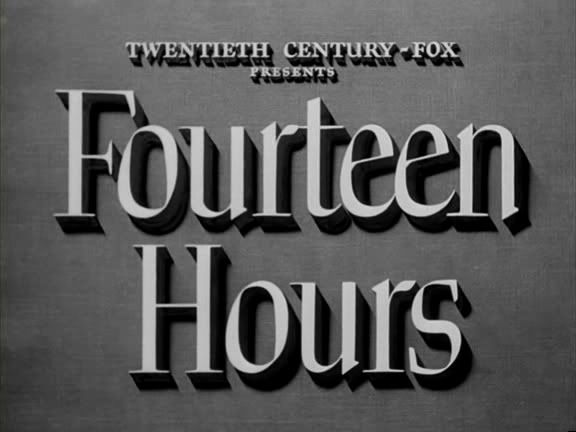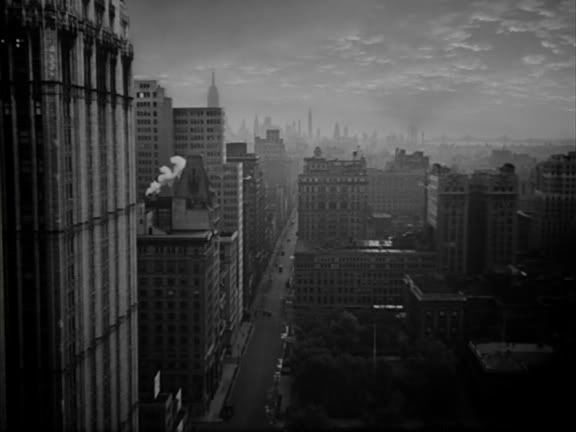Fourteen Hours (1951)
Fourteen Hours
Screenplay: John Paxton
Based on the article The Man on the Ledge by Joel Sayre
Producer: Sol C. Siegel
Music: Alfred Newman
Cinematographer: Joseph MacDonald
Editor: Dorothy Spencer
Cast: Paul Douglas, Richard Basehart, Barbara Bel Geddes, Grace Kelly
Robert Cosick (Richard Basehart) threatens to jump from a ledge on the fifteenth floor of the Hotel Rodney. Traffic cop Charlie Dunnigan (Paul Douglas) remains the only person he's willing to talk to, even after the police bring in doctors, experts, and his mother Christine (Agnes Moorehead). The spectacle becomes a TV marathon as hundreds of people line the sidewalks ... including prospective sweethearts Ruth and Danny (Debra Paget and Jeffrey Hunter) and a young couple headed for divorce court, Mr. and Mrs. Fuller (Grace Kelly and Leif Erickson). Police tricks fail and Dunnigan only barely retains Cosick's confidence, until Cosick's ex-fiancée is located, Virginia Foster (Bel Geddes).
'FourteenHours,' Fox Film About Man on Ledge Ready to Jump, Telling Drama of Astor
New Yorkers who vividly remember the case of the man on the ledge-the poor chap who lodged himself grimly on a high cornice of a local hotel one summer day back in 1938 and stood there teetering while rescuers labored and the city held its breath-will tautly relive that curious drama in Twentieth Century-Fox's "Fourteen Hours," a remarkably compact motion picture that came to the Astor yesterday. And likewise, those who have no memory of that or any similar case will find gripping suspense, absorbing drama and stinging social comment in this film.
For Fox has taken the story of that poor, unbalanced young man, as it recently was recollected in The New Yorker magazine by Joel Sayre, and has staged it, with liberal alterations and some added atmospheric details, to put on display a hotly throbbing and brutally candid slice of metropolitan life. Fitly directed by Henry Hathaway in a crisp journalistic style and played to the hilt down to its "bit" parts, it makes a show of accelerating power.
To be sure, the precarious situation of a person perched upon a narrow ledge, high above the streets of a city, is a "natural" for dramatic suspense. All of the latent primitive phobias of falling and of dizzying heights may be played upon in this situation-and the most is made of them in this film. Less than three minutes after the picture opens, the young man is wobbling on the ledge, with the street far below, and there he teeters, in full and persistent view, with sudden and sickening slips and catches, until just before the end.
But John Paxton, who wrote the screen play, certainly did not rest with that. The man on the ledge is but the pivot upon which a tumbling drama builds. And it is this accumulating drama-of the traffic cop off the local beat; of the poor young man's mother and father, brought to plead with him; of the frantic, fumbling rescue efforts and of the morbid, cruel crowds in the street-that makes for the real emotional upsweep and the hard, staggering shocks in this film.
For the fact which has here been wisely realized and intelligently acted upon is that an incident of the sort set in this picture becomes a focus for the drama of man. Here, within the full view of millions, a person teeters between life and death, his will free to make his destruction, while the hypnotized observer speculates.
What Mr. Paxton has imagined, based loosely on Mr. Sayre's report, is a sad case of maladjustment, caused by unhappy parents and a broken home. And this little personal drama, pieced together in a crowded hotel room, near to the threatening "jumper," emerges most pathetically in the film. But alongside of it (and nigh as touching) is the day's experience of a simple New York cop who happens to be the individual who comes closest to the man on the ledge. And around and about swirls the drama of reporters and heartless radio men, the curious crowds looking on in breathless horror or with lust for a death-spectacle. Except for one minor street incident between a watching boy and girl and a banal episode in a lawyer's office, the tight tapestry of drama is superb.
In the role of the "jumper" Richard Basehart does a startling and poignant job within the limitations of one square foot of acting space. But Paul Douglas, with room to move around in, takes the honors as the good-natured cop who finds all his modest resources of intelligence and patience taxed by this queer case. Howard Da Silva is also excellent as a methodical, hard-headed deputy chief inspector of police, and Agnes Moorehead is brilliantly effective as the neurotic mother of the man on the ledge. Robert Keith as the father, Barbara Bel Geddes as the sweetheart and Martin Gabel as a psychiatrist are just a few of the many others who bring personality and credibility to this superior American film.
Bosely Crowther, NY Times, March 7, 1951
http://www.filesonic.com/file/31078587/14 Hours (1951).avi
http://www.fileserve.com/file/5nJSrQQ/14 Hours (1951).avi
Etiketler: 1951, Drama, Dran, USA
Kaydol:
Kayıt Yorumları (Atom)




0 yorum:
Yorum Gönder
Not: Yalnızca bu blogun üyesi yorum gönderebilir.